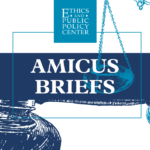Published December 28, 2005
Now that the initial dust over the Congregation for Catholic Education’s recent Instruction on homosexuality and candidacy for the priesthood has settled, three points seem worth underscoring.
The first point is one of historical and theological context.
On December 8th, the Solemnity of the Immaculate Conception, the Church marked the fortieth anniversary of the conclusion of the Second Vatican Council – a reforming Council intended by John XXIII to prepare the Church for what John Paul II would later call a “springtime of evangelization.” Historically, we must remember that every great period of reform in Catholic history has included a reform of the priesthood and the consecrated life. Theologically, we must understand that there can be no “reform” of any facet of Catholic life without reference to “form:” in this case, the “form” in question is the priesthood understood as an iconic embodiment of the eternal priesthood of Jesus Christ. Christ’s eternal priesthood, in turn, involves Christ’s spousal relationship with his bride, the Church. Keeping those truths of history and theology in mind is essential for reading the recent Instruction from Rome correctly – which is to say, as a reforming document.
The second point is one of cultural context.
Living chastity is no easy business in the sex-saturated culture of the contemporary West. It’s impossible to walk through a mall, turn on your computer or television, or browse through a bookstore without being bombarded by sexual imagery of every imaginable sort. The challenge of living chastely in these circumstances is a tough one for everybody: single, married, or celibate, lay or ordained. That is one important reason why the appropriate authorities in the Church – pastors, diocesan vocation directors, seminary faculty, seminary rectors, religious superiors, and, above all, bishops – must be as certain as humanly possible that a man is capable of living the demanding vocation of chaste celibate love before he is called to Holy Orders.
That responsibility cannot be out-sourced to psychologists and psychiatrists. Why? Because, in the final analysis, it’s a judgment of pastoral prudence, not a clinical judgment. The evaluation of clinicians can be helpful in forming a judgment about a man’s capacity for living chaste celibate love in today’s sexual free-fire zone. But the final call rests with the Church’s pastoral authorities. And as the Long Lent of 2002 made unmistakably clear, it is a responsibility that cannot be shirked.
Candidates for the priesthood, whether diocesan or religious, also have a responsibility here, particularly given the challenging cultural circumstances in which they propose to serve. Any prospective candidate for ordination should be prepared and willing to demonstrate his capacity to live chaste celibate love before he asks the Church to confirm his vocation to the ordained ministry. Indeed, a willingness to do so might be considered an important sign of whether or not a man’s sense that God is calling him to a priestly vocation is a true discernment.
The third point takes us to the bottom of the bottom line.
Will this document make any difference? That is, will it help foster a genuine and enduring reform of the priesthood? That is entirely up to local bishops, in the case of the diocesan priesthood. A bishop must take the time and trouble to know his seminarians before he issues the canonical call to Orders. If a bishop’s first real encounter with a man he is to ordain happens on the day of that man’s ordination, something is seriously wrong. As for men’s communities of consecrated religious life, which seem to be the primary (albeit not exclusive) locus of unchaste clerical “gay culture” today, no Roman document can substitute for courageous leadership by religious superiors, calling all under their authority to live the “more excellent way” by honoring the majesty of their vows.
In the providence of God, the Long Lent of 2002 could not have been meaningless: it was, in retrospect, a call to the entire Church to take the reform of the Church’s ordained ministry with the urgency Vatican II proposed. The recent Instruction is a response to that call, and should be welcomed as such.
George Weigel is Distinguished Senior Fellow of Washington’s Ethics and Public Policy Center, where he holds the William E. Simon Chair in Catholic Studies.








